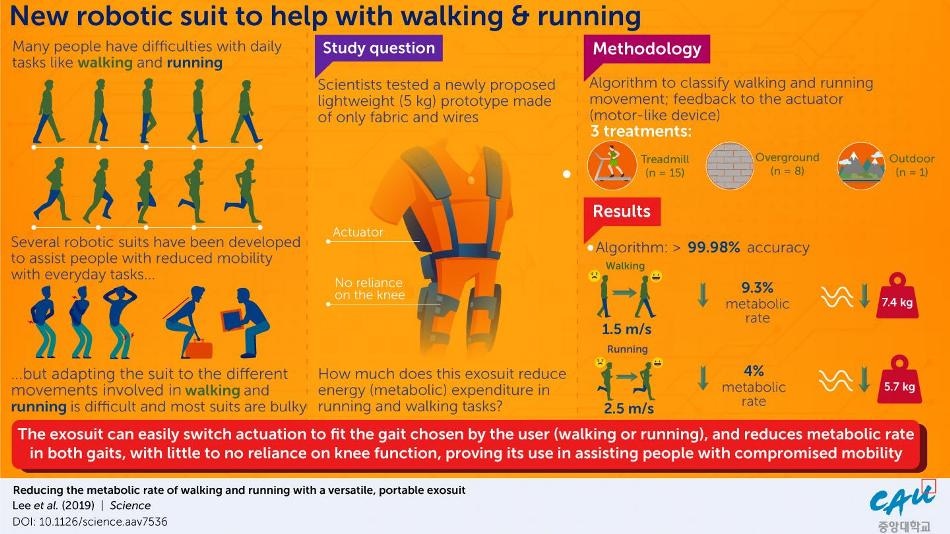Oct 22 2019
Walking may not look like a big task for most people, but for others, this basic activity can often feel strenuous. For patients recovering from stroke or surgery, those with restricted mobility, those with Parkinson's Disease, and even for firemen or soldiers carrying heavy loads over tough terrain, walking or running can be a difficulty.
 Newly developed robot suit made of fabric vest and wires will help people with restricted mobility to walk and run more efficiently. (Image credit: Chung-Ang University)
Newly developed robot suit made of fabric vest and wires will help people with restricted mobility to walk and run more efficiently. (Image credit: Chung-Ang University)
Many scientists have deliberated over this issue for many years, designing several external devices that, once worn by users, enable them to move, walk, and run a lot more effortlessly than they usually would. Several types of "robotic exoskeletons" or robotic suits have been built over the years, with an aim to lower the users' energy expenditure (or metabolic rate) when running and walking.
Robotic exoskeletons tend to be bulky and heavy; and while walking experiments have shown promising results, the energy spent running with the added weight of the device outweighs the benefits of robotic assistance.
Giuk Lee, Professor, Chung-Ang University
The issue, as Prof Lee and colleagues describe in their paper published in Science, lies in the fact that "Walking and running have fundamentally different biomechanics, which makes it challenging to develop devices that assist both gaits." Confronting this challenge, the researchers reveal their newly built exosuit, generally comprising a fabric vest, belt, and thigh wraps, similar to clothes that people wear in daily life. These components are linked by wires, and equipped with batteries and a motor-like device (an actuator).
The device weighs only 5 kg, easily fitted around the waist to support hip extension muscles and allow a better range of movement. Furthermore, this exosuit can turn on the assistance mode automatically between walking and running gaits to realize maximum effectiveness of assistance.
The prototype developed by the researchers was tested on outdoor courses with varying terrains and on treadmills to analyze the energy savings realized by the exosuits under various conditions. They used an algorithm to categorize gait (running or walking), which delivered feedback to the device and modified the assistance mode based on that.
This enabled the exosuit to keep up with the movement started by the actuator to the gait identified by the algorithm, and consequently to maximize energy savings.
Indoor and outdoor testing exposed that the algorithm was able to accurately identify walking and running gaits over 99.98% of the time.
Once they had verified the accuracy of the algorithm, the researchers explored the metabolic savings accomplished by the exosuit's assistance functionalities. They learned that exosuit assistance reduced the energy cost of walking at a speed of 1.5 m per second (4.8 km per hour) by 9.3%, equivalent to the user losing 7.4 kg.
They were also effective in securing energy savings during running tasks (speed of 2.5 m per second or 9 km per hour), where the assistance function decreased metabolic rate by 4%, corresponding to a weight loss of 5.7 kg.
Such energy savings might look trivial, but according to Prof Lee and colleagues, "Although the changes in metabolic rate are relatively modest, they are of similar magnitude to those that have been proven sufficient to improve maximum walking and running performance. Therefore, we think that these energy savings could result in proportional increases in maximal performance, for example, over a cross-country course."
Lastly, in contrast to earlier exosuits, which depended greatly on knee function, this new device uses hip extension to stimulate the leg movement, making the exosuits especially appropriate for above-knee amputees and other people lacking total knee function. By exploiting the power of the hip extension, users of this robotic suit will be able to accomplish higher athletic performance in a range of terrain, effortlessly switching between running and walking as required.
We are expecting that this 'wearable robot' will have many uses, such as in aiding rehabilitation training for senior patients and enhancing the work efficiency of soldiers or firemen. In the long term, we envision this exosuit as hanging in a closet all the time, just like the clothes we wear every day.
Giuk Lee, Professor, Chung-Ang University